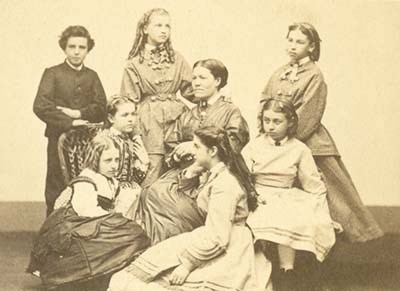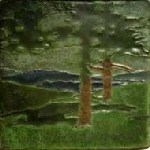

Left image
Right image

NPS Photo Perhaps in This Very RoomTradition holds that this room, along with the one behind it, served as George Washington's private chambers during his nine-month stay (July 1775 - April 1776) in the Vassall House. Some sixty years later, Henry Longfellow, then a professor at Harvard, rented the same two rooms from Elizabeth Craigie. He was prepared to believe this tradition, writing to his father:
Thirty-four years later, Longfellow's daughter Edith carried out the same exercise during the centennial year of the Revolution. Evidently, she was even more convinced than her father of the truth of the Washington tradition:
Though documents do not confirm which room Washington slept in during his time in Cambridge, it is safe to say, as Longfellow did, that it was "certainly in this very house." Bachelor StudyFrom 1837 to 1844, this room served as Henry Longfellow's study, and for much of that period, his dining room. He had the room furnished with a writing table, sofa, and a piano. Here, Longfellow enjoyed the society of the "Five of Clubs" - fellow literary young men Cornelius Conway Felton, Henry Cleveland, George Hillard, and Charles Sumner. For the first year of their marriage, this was Henry and Fanny Longfellow's "library," as she called it in a letter: "the Library, you remember with its cozy fauteuils, heroic bust of Greene and goodly bookcases, topped by plaster worthies, its tiled fireplace, old-fashioned mirrors, etc. A few feminine changes alone have intruded, but it is mainly the same." In 1844, the study was moved downstairs, a change which Henry Longfellow lamented: "Alas! The old study! now given up as a playroom to noisy Charley, whose feet incessantly patter over my head. Those were lovely days and nights, above there! The room is so full of associations..." 
Longfellow Family Photographs (3007-2-2-4-11) Nursery and SchoolroomAs their family grew, the former study was adapted into a playroom, nursery, schoolroom, and bedroom for the children. It was from this "chamber above" the study that Longfellow described hearing "The patter of little feet" in his poem "The Children's Hour." From 1861 to 1868, governess Hannah Davie used the room as a classroom for the Longfellow daughters and some of their friends. Upon their return from a European Grand Tour in 1869, Edith and Annie, the youngest Longfellow children, transformed this room into their Colonial Revival-influenced bedroom. 
NPS Photo Progressive Era StudyAlice Longfellow began using the room as her study in the 1890s. The room is today furnished as Alice used it around 1912-17. She used a library table for her desk, as well as a secretary type desk and bookcase between the windows. Several upholstered chairs, a sofa, and a daybed provided comfortable places to relax or read. Alice was an active member of the Society of Arts and Crafts, which promoted beautiful, well-made design of everyday objects. Her interest in the movement is evident in her decorative choices, including Arts and Crafts vases and a tile by Grueby. |
Last updated: February 2, 2022
